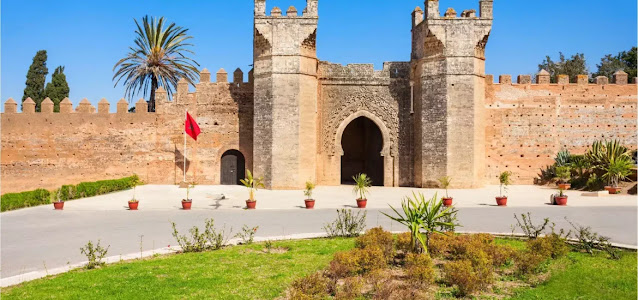Discovering Rabat: The Majestic Capital of Morocco
Rabat, the capital city of Morocco, is a vibrant tapestry of historical grandeur, strategic significance, and modern elegance. Nestled along the Atlantic coast, this city is not only the political and administrative heart of the Moroccan Kingdom but also a captivating destination brimming with cultural heritage and architectural splendor. In this blog, we delve into the essence of Rabat, exploring its population, strategic importance, historical background, and the top ten places to visit.
Population and Position
With a population of approximately 700,000 residents, Rabat is one of Morocco's major cities, though it is less populated than its bustling counterparts like Casablanca or Marrakech. The city serves as a vital administrative hub and a center of diplomacy, housing numerous government institutions, embassies, and royal palaces. Its strategic location along the Atlantic coast provides it with a scenic maritime backdrop and facilitates its role as a key player in both national and international affairs.
Strategic Importance
Rabat’s significance extends beyond its administrative role. Strategically situated on the western edge of the Moroccan Kingdom, it offers a crucial maritime gateway with its expansive port. Historically, the city's location was instrumental in trade and defense, acting as a crucial link between Morocco and Europe. The city’s coastal position allowed it to become a prominent center of commerce and cultural exchange throughout history. Today, Rabat continues to thrive as a modern metropolis while preserving its rich heritage.
Historical Background
Rabat’s history is a blend of diverse influences, reflecting its role as a crossroads of civilizations. The city’s origins trace back to the Roman period, but its most significant development began during the Islamic era. In the 12th century, the Almohad Caliph Abd al-Mu’min established Rabat as a fortified city. This period marked the construction of the iconic Hassan Tower and the Kasbah of the Udayas, both of which remain key landmarks today.
The city’s historical evolution continued through the Merinid period and the French protectorate era, each leaving a unique imprint on Rabat's cultural and architectural landscape. Following Morocco's independence in 1956, Rabat was chosen as the capital, cementing its status as the political center of the nation.
Top 10 Places to Visit in Rabat
The Hassan Tower is perhaps the most iconic symbol of Rabat. Originally intended to be the minaret of an enormous mosque commissioned by Sultan Yacoub al-Mansour in the 12th century, the tower stands incomplete at 44 meters high. Its unfinished state adds to its historical charm, while the surrounding ruins of the mosque and the expansive open area provide a fascinating glimpse into Morocco’s medieval architectural ambitions.
Adjacent to the Hassan Tower, the Mausoleum of Mohammed V is a magnificent example of modern Moroccan architecture blended with traditional elements. This mausoleum is the final resting place of King Mohammed V and his sons, King Hassan II and Prince Abdallah. The mausoleum’s intricate tile work, stunning marble floors, and serene atmosphere make it a significant and serene site to visit.
Perched on a cliff overlooking the Atlantic Ocean, the Kasbah of the Udayas is a historic fortress with roots dating back to the 12th century. Its labyrinthine streets, whitewashed houses with blue accents, and the picturesque Andalusian Gardens offer visitors a glimpse into Rabat’s past. The kasbah also boasts spectacular views of the river and ocean, making it a popular spot for both history enthusiasts and photographers.
The Royal Palace, or Dar al-Makhzen, serves as the residence of the Moroccan king and his family. While the palace itself is not open to the public, visitors can admire the stunning architecture and expansive grounds from the outside. The grandeur of the palace complex, with its impressive gates and lush gardens, reflects the opulence of Moroccan royalty.
For history buffs, the Rabat Archaeological Museum is a treasure trove of artifacts spanning Morocco’s ancient past. The museum’s extensive collection includes prehistoric tools, Roman sculptures, and Islamic pottery. Notable exhibits include the famous 7th-century sculptures of the “Giant of the Chellah” and a range of ancient coins and inscriptions.
The ancient ruins of Chellah are a fascinating site located just outside Rabat. This medieval necropolis was originally a Roman city known as Sala Colonia. The site features impressive ruins, including a Roman bathhouse, and the remains of a 14th-century Islamic tomb complex. The tranquil gardens and the surrounding ruins offer a unique atmosphere for exploration and reflection.
Located within the Kasbah of the Udayas, the Andalusian Gardens are a serene escape filled with lush greenery, vibrant flowers, and tranquil fountains. Designed in the traditional Andalusian style, these gardens provide a peaceful retreat and a beautiful setting for leisurely strolls.
For those seeking relaxation, Rabat Beach offers a delightful stretch of sandy coastline where visitors can unwind, swim, or enjoy a leisurely walk along the shore. The beach provides a picturesque view of the Atlantic Ocean and is a great spot to experience Rabat’s coastal charm.
Jardin d’Essais
The Jardin d’Essais, or Experimental Garden, is a beautifully landscaped botanical garden in Rabat. Originally created during the French protectorate as a place for agricultural experimentation, it now serves as a lovely public park. The garden features a diverse collection of plant species, tranquil paths, and shaded areas, making it an ideal spot for relaxation and leisurely exploration.
For a dose of contemporary culture, the Mohammed VI Museum of Modern and Contemporary Art showcases a dynamic collection of Moroccan and international art. The museum’s striking modern architecture complements its diverse exhibitions, which include paintings, sculptures, and multimedia works. It’s a cultural hub that highlights Morocco’s growing artistic scene.
Rabat stands as a testament to Morocco’s rich history and vibrant present. Its blend of ancient landmarks, modern attractions, and strategic importance makes it a captivating destination for travelers and a significant center for the Moroccan Kingdom. Whether you're exploring its historic sites, relaxing on its beaches, or immersing yourself in its cultural offerings, Rabat promises a memorable experience that beautifully encapsulates the essence of Morocco.



.jpeg)



.jpeg)





